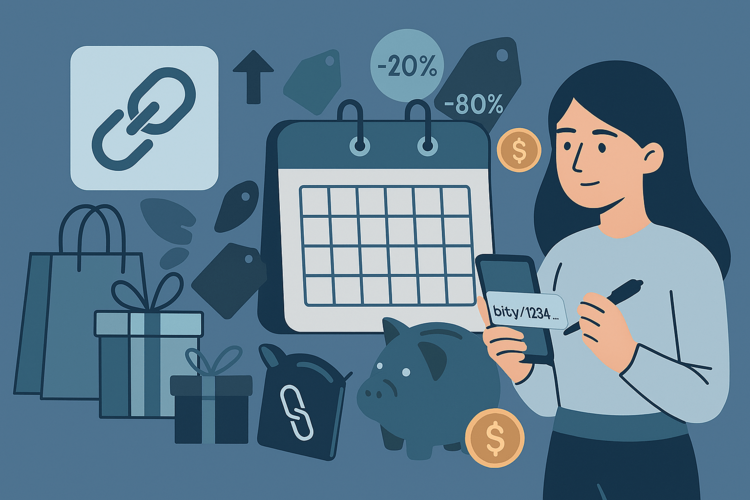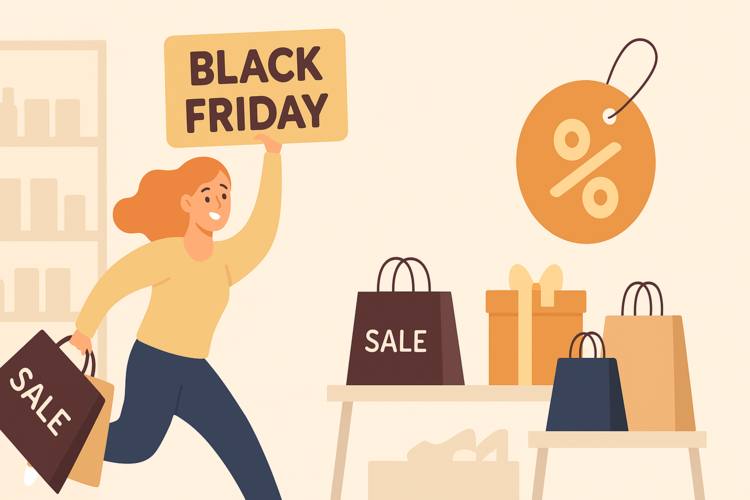Black Friday isn't just a day when the internet explodes with "80% off" banners and marketers become masters of psychological attacks. It's a real stress test for common sense. On this day, push notifications pour in as if someone owes you money, website timers tick like bombs in action movies, and FOMO is in full swing: "buy now or never." And it's very easy to succumb to this "everything is urgent" atmosphere and then sit at home with an empty wallet and a mountain of things you bought because they "looked good" but didn't add any real value.
Optimize your links. Catch Black Friday bonuses!
Register on surl.li and control your links!
But there's another side to it. Black Friday can be a great time to upgrade your tech, close out important purchases, and really save money—if you approach it with a cool head and at least a minimal plan. It's not about heroism, it's about strategy.
Below are 15 tips that will help you avoid turning an emergency into an emergency (Pure Failure) and get through this day in a way that will allow you to be proud of your purchases later, rather than hiding them in the closet.
Preparation: charging common sense
1. Create a shopping list (but a real one, not one that you “suddenly need”)
A list is your personal anti-FOMO. While it's still quiet around you, sit down and honestly write down what you really need: appliances, household items, subscriptions, holiday gifts. Don't add "maybe it will come in handy someday." Such things then lie in the closet for more than a year and remind you of themselves only with remorse. If the product was not important in October, it will not become vital on Black Friday. A list disciplines, reduces chaos and cuts off impulsive purchases that seem profitable only at the moment.
2. Check price history in advance
Half of the “discounts” during the state of emergency are simply a return to the price that was a month ago. Therefore, before you go hunting, go to services with price history. The graph will show: the product has really become cheaper or is it a classic maneuver “they raised it yesterday, they lowered it today”. Some stores play hardball, increasing the price a few days before the state of emergency, and then cutting it by a solemn “–40%. ” You see the discount, and your brain is already celebrating the victory. But numbers are stubborn things. If the price history is stable, and the difference is really noticeable, then you can take it.
3. Choose stores with a reputation, not the biggest numbers on the banner
Cool banners don't guarantee anything. Stores with "–90%" can exist only during the promotion and disappear in two weeks, leaving you with questions instead of the product. So it's important to focus not only on the price, but also on who you trust. Read real reviews, see the date the site was created, check SSL, social networks, and the quality of support. A good store doesn't hide contacts, doesn't post poorly translated texts, and doesn't avoid details. Reliability looks boring, but it saves money and nerves.
4. Compare shipping and return policies
Shipping is the second price of the product, just hidden. Two identical phones may cost the same, but one will arrive in three days and have a free return policy, while the other will take two weeks to arrive and will only accept returns “in the event of a manufacturing defect.” This is not a small thing. Before buying, check the terms, return policies, delivery methods, and who is responsible for logistics. If the return policy is confusing or sounds like a legal quest, it’s better to choose another store.
During the sale: playing it clean and cool
5. Use filters and sorting — it saves both time and nerves
Black Friday is thousands of products where it's easy to get lost. But filters are your GPS. Choose a price, category, brand, features - and you'll save an hour of wandering around the site and avoid an accidental purchase "because I just saw it." Algorithms work better than our brains at the moment of sales noise. In addition, filters cut off junk and fakes, which often appear during emergencies. Smart sorting is the way to a real purchase, not a chaotic grab.
6. Use promo codes (yes, sometimes they even work on top of discounts)
It sounds like a myth, but some stores really do allow you to use a promo code on top of Black Friday. Especially local brands or those that want to increase the average check. Checking it is a matter of 10 seconds. Even if the promo code gives 5-10%, it is still extra money that remains in your budget. There are browser extensions that automatically go through all possible codes. Sometimes they find something that you would never have come across manually.
7. Enable cashbacks
Cashback is not magic, but a little life hack that always works, but especially for large purchases in emergency situations. Monobank, LetyShops, Rakuten, cashback plugins in the browser - all this can return you 3-10% on top. This does not look like a big discount, but if you buy appliances, furniture or several products at once, the amount is very tangible. The main thing is not to forget to turn it on, because during the hype, such things are the last thing people remember.
8. Subscribe to the store's push and email during the emergency
Yes, most promotional emails are boring. But on Black Friday, they can be your advantage. Stores often send personal codes or open the promotion earlier for those who are on the mailing list. This means that you don't come in when the product is already on the verge of being sold-out, but at the start, when the choice is maximum. Subscribe for a few days, take advantage of the advantage - and calmly unsubscribe after the promotion.
9. See who the seller is: a store or a marketplace intermediary
There is one peculiarity in large platforms: some of the goods are not sold by them, but by third-party sellers. It is among them that counterfeits, “miracle warehouses”, strange guarantees or “we will ship tomorrow” for three weeks are most often found. If you want no surprises, choose goods marked “official seller” or “marketplace delivery”. This does not guarantee perfection, but the risk of a mistake is much lower.
10. Don't get carried away by "10 minutes left" timers
Timers are a favorite pressure tool. Most of them update automatically, creating the illusion of “buy now or lose out.” It’s a psychological trick that plays on the fear of missing out. In real restrictions, you’ll see other signs: the product quickly disappears from stock, buyers are actively commenting, the store publishes updates about the remaining stock. If the timer is running out and the product is available all day, that’s theatrics, not shortages.
11. Only buy what you can return.
On Black Friday, there is a hard logic at work: when emotion is stronger than rationality, the chance of making a mistake in the purchase increases. Therefore, it is important to buy where there is a transparent return policy. Even if you are sure - life is different. You can open the box and realize that the color is not the same, it makes more noise than it seemed, or you simply do not need it. 14-30 day returns are your insurance.
After Shopping: The Finish Line (and a Little Analytics)
12. Check the product immediately upon receipt
The most common mistake is to postpone unpacking "until the weekend." And then find out that the return deadline has already passed. During a state of emergency, the volume of orders is huge, so the chance of manufacturing defects increases. Open the box immediately: check the screen, package, sound, build quality. If something is wrong, write to support immediately. Stores are more willing to meet the deadline when the problem is detected in the first hours, rather than a week later.
13. Save receipts, warranties, order numbers
During sales, you may have up to a dozen purchases - everything gets mixed up, documents get lost, receipts are thrown away along with the box. And when the product suddenly breaks, a quest begins in the style of "what did I buy, where did I buy it and who will sell it back to me?". A simple photo of all the documents on your smartphone solves the problem immediately. Save them in a separate folder - it's a minute of work and months of peace.
14. Keep a summary of your expenses (even a rough one)
After an emergency, it’s useful to do a small audit: what you bought, how much you needed, whether you really saved money. This isn’t boring accounting — it’s a way to understand your purchases and see patterns. Maybe you buy the same thing every year “because there was a sale,” or you spend the most on things you use only once. A brief analysis will save you money next year.
15. Cancel all unnecessary subscriptions made "because there was a promotion"
Subscriptions are the most insidious type of expense. You pay little, but regularly and imperceptibly. In the event of a sale, many services offer “–50% for the first month”. It’s easy to get, but difficult to unsubscribe. Therefore, after a sale, go through all your subscriptions: think about what you really use and what is lying around as dead weight. It’s better to close the unnecessary ones right away than to pay all year for something you haven’t opened since December.
Bonus: useful sites and tools for saving
Black Friday is not only about focus and discipline, but also about tools that can think for you. At a time when stores are trying to "sweeten" the price or, conversely, disguise a fake discount, it's useful to have services at hand that cut through the marketing fog to the bone. These are the same tools that help you understand whether you're getting a real deal or just a pretty banner:
Hotline.ua and Price.ua are must-haves for any Ukrainian buyer. These are not just sites with prices, but databases where you can see how the cost of a product has changed over weeks and months. If the price was stable, and then suddenly “fell” during the emergency, that’s great. If it first “jumped” and then “fell” – it’s a chess maneuver that’s easy to recognize right here.
Cashback services: Monobank, LetyShops, Rakuten. Even when it seems to you that the discount is already maximum, cashback returns another 3–10% on top. It is especially useful for large purchases: appliances, furniture, gadgets. It is only important to enable cashback before payment - because this is what is most often forgotten.
Keepa (for Amazon) is a tool without which it is better not to visit Amazon in case of emergency at all. Keepa shows a price graph over the years: a real drop or a marketing one "drawn for a promotion." It also warns about hidden discounts that Amazon itself does not always see.
ShopGenius and Honey are wonderful browser plugins that automatically scan for promo codes. If there is a working code, they will find it faster than you can Google it. Sometimes it gives small bonuses, sometimes it gives a very nice minus 10–20% on top of the PE.
These are all small but very effective helpers. They save you from marketing traps, save you money, and leave you feeling like you won Black Friday this year.
Conclusion
Black Friday is a marathon, not an attack on your wallet. The best deals aren't made by those who "catch a bargain," but by those who know what they're looking for. Conscious shopping is a superpower: it saves money, nerves, and closet space. Everything else is just marketing hype.




